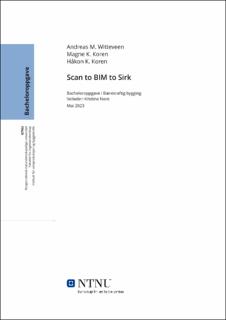| dc.description.abstract | Denne bacheloroppgaven handler om hvordan man kan bruke en kombinasjon av digitale verktøy, manuelle målinger og dataanalyse til å vurdere det miljømessige og økonomiske beslutningsgrunnlaget for ombruk av eldre låvematerialer.
Den norske boligmassen, næringsbygg og industri står fortsatt for en betydelig mengde av det totale energi og materialforbruket.
Av alt treavfall som ble levert i 2021 gikk 72% av dette til forbrenning og resten til materialgjenvinning. Dette er en positiv utvikling ifra 2020, da var andelen 87 prosent forbrent avfall (Miljøstatus, 2022). Det er avfallsmessig fortsatt mye å hente og denne oppgaven er laget for å støtte overgangen ifra lineær til sirkulær økonomi. Omtre AS og prosjektet SirkTRE har som mål å løfte byggenæringen og treindustrien ved å gjennomføre ulike arbeidspakker, som totalt sett skal fremme det grønne skiftet og øke andelen av returtre i byggeprosjekter.
Denne oppgaven har som mål å besvare problemstillingen:
Hvordan kan Scan to BIM forbedre det økonomiske og miljømessige beslutningsgrunnlaget for ombruk av eldre bygningsmaterialer?
For å svare ut problemstillingen mest mulig har vi først jobbet med å kartlegge en gammel låve ved hjelp av 3D-skanning og manuelle fukt målinger. Disse dataene skal blant annet hjelpe oss å modellere, kategorisere og sortere de ulike bygningmaterialene.
Videre har vi brukt kjente verktøy for å scenariomodellere beslutningsgrunnlaget for valgt låve.
Punktskyen, medfølgende bilder og fukt analyse hjelper oss å kvantifisere hvilke materialer som egner seg til ombruk i sin helhet og hvilke som kan inngå til oppflisning. Egne kriterier er definert i oppgaven. For å gi myndigheter, boligeiere, bedrifter og andre interessenter større innsikt i hvilken påvirkning økonomisk og utslippsmessig ulike scenarioer gir, har vi innhentet antatte priser for returtre. I tillegg har vi vurdert CO2 avtrykket til nye potensielle ombruksprodukter og prosesser og sammenlignet dette mot nytt trevirke ved hjelp av LCA. Deretter ble det videre brukt til å sette opp ulike scenarioer for avhending og videre prosessering.
Ved å sette opp scenarier på denne måten ble det enklere å forstå helheten ved det generelle beslutningsgrunnlaget for demontering, riving og produktevaluering til nye produkter ifra returtre i sammenligning ifra nytt tre.
Oppgaven viste at ved å ha et godt datagrunnlag er det enklere å kvantifisere, planlegge og vurdere nye metoder, prosesser og produkter.
Scan to BIM i kombinasjon med manuelle målinger og LCA gir oss altså god innsikt i hvilke materialer og avhendingsscenarioer vi kan bruke til hvilke prosesser/produkter.
Resultatene viser dermed at Scan to BIM er en egnet metode å forbedre det økonomiske og miljømessige beslutningsgrunnlaget. | |
| dc.description.abstract | This bachelor’s thesis is about how to use a combination of digital tools, manual measurements, and data analysis to assess the environmental and economic decision-making basis for the reuse of older barn materials.
The norwegian housing stock, commercial buildings and industry still account for a significant amount of the total energy and material consumption.
Of all wood waste delivered in 2021, 72% of this went to incineration and the rest to material recycling. This is a positive development from 2020, when the proportion was 87% incinerated waste (Miljøstatus, 2022). In terms of waste, there is still a lot to improve, and this thesis is designed to support the transition from a linear to a circular economy. Omtre AS and the project SirkTRE aim to lift the construction industry and the wood industry by carrying out various work packages, which overall will promote the green shift and increase the proportion of recycled wood in construction projects.
The aim of this thesis is to answer the following question:
How can Scan to BIM improve the economic and environmental decision-making basis for the reuse of older building materials?
To answer the thesis as best as possible, we first worked on mapping out an old barn using 3D-scanning and manual moisture measurements. Among other things, this data will help us to model, categorize and sort the various building materials.
Furthermore, we have used known tools to model the decision-making basis for the chosen barn.
The point cloud, accompanying images and moisture analysis help us quantify which materials are suitable for re-use in their entirety and which can be used for chipping. Own criteria are defined in the assignment. In order to give authorities, homeowners, companies and other stakeholders greater insight into the economic and emissions related impact of different scenarios, we have obtained assumed prices for reclaimed wood. In addition, we have assessed the CO2 footprint of new potential materials and processes/products using LCA. This was then further used to set up various scenarios for disposal and further processing.
By setting up scenarios in this way, it became easier to understand the entirety of the general decision-making basis for disassembly, demolition and product evaluation for new products from reclaimed wood.
The assignment showed that by having a good data basis it is easier to quantify, plan and assess new methods, processes and products.
Scan to BIM in combination with manual measurements and LCA gives us thereby a good insight into which materials we can use for which processes/products.
The results thus show that Scan to BIM is a suitable method to improve the economic and environmental basis for decision making. | |
